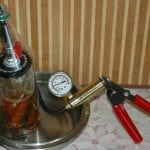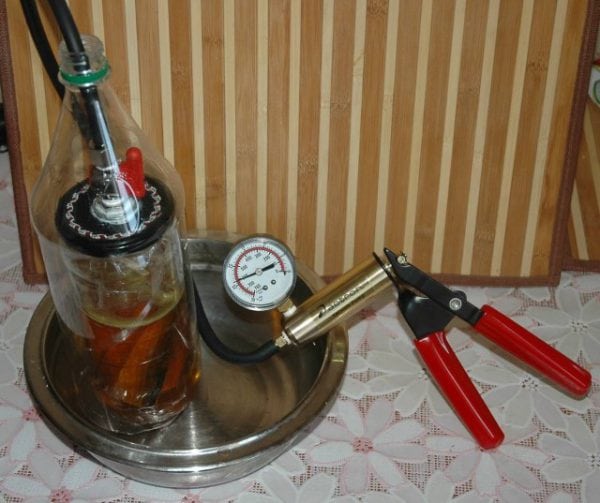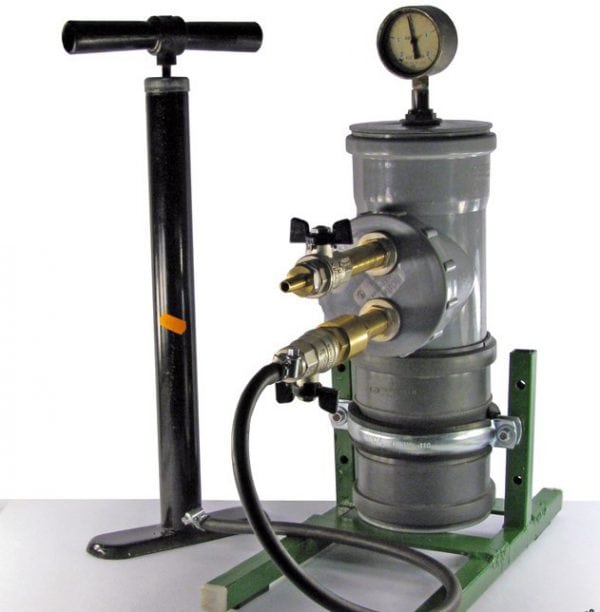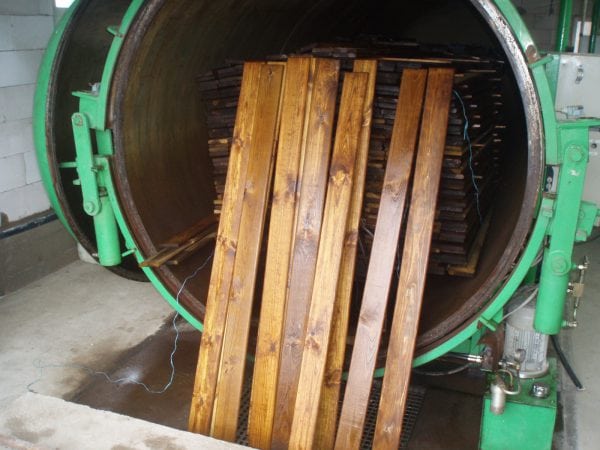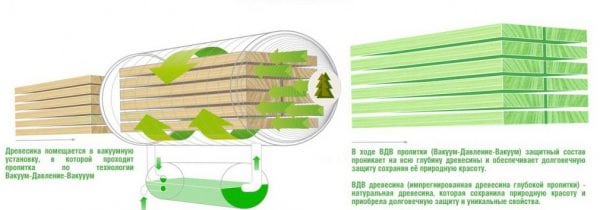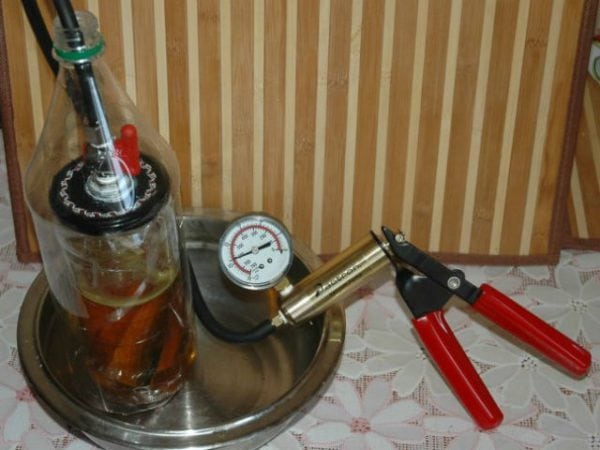For many centuries, a person does not cease to admire the beauty of wood and tries, as far as possible, to protect a tree from aging and decay. For this purpose, many impregnations, antiseptics, flame retardants are available that can reduce the harmful effects of the environment and extend the life of the product. The most modern method is vacuum impregnation.
Using this technique allows the protective composition, due to reduced pressure, to penetrate to a depth of 5 cm, depending on the type of wood and the method used. For comparison: conventional brush or roller application allows penetration of up to 2 mm.
to contents ↑Benefits of Using Vacuum
Unfortunately, this technology is available only in industrial conditions and requires special equipment, and the finished material costs almost twice as much. However, vacuum impregnation of wood provides several advantages:
- Reliably protects for many years from rot, mold, various insects. The board does not rot, even if it is constantly in contact with water or earth. It does not require repeated treatment with antiseptics.
- Fire-retardant impregnation makes the wood non-flammable or even non-combustible, significantly increasing the fire safety of buildings.
- Modern protective equipment for vacuum technology, as a rule, is available on a water-dispersion basis, others are less commonly used. All of them are environmentally friendly, safe for people and animals.
- After impregnation with the help of special equipment, the tree retains its unique texture, but becomes more durable: it does not dry out and does not crack.
The process of saturation (impregnation) of wood with solutions is carried out on specialized industrial equipment under the influence of the pressure difference in the sealed chamber of the autoclave and takes, depending on the type and quality of the material, 3.5-6 hours.
The liquid pressure in this apparatus reaches 12 kg / cm2, the length of the apparatus is 10-15 m, and the diameter is 1.5-3 m. The equipment has:
- manual or automated control unit;
- Pressure Sensors;
- valves
- capacity for antiseptic solution.
The autoclave treatment parameters and the characteristics of the impregnating mixture (flame retardant, antifungal) affect the resistance of wood to various lesions and its strength. Typically, the life of the board after the vacuum impregnation is done is 60-70 years. During this time, she will not need additional antiseptic or flame retardant treatment. Such cosmetic material can be simply repainted during cosmetic repairs, having previously cleaned and removed the old layers of the decorative coating.
to contents ↑How does autoclaving work?
Before loading wood into an autoclave, it should be prepared:
- To dry. Humidity should be no more than 25%. Exceeding this parameter will negatively affect the final result.
- Sort (by uniformity of impregnation: the peripheral part of the wood absorbs the compositions very well, and the core is almost impenetrable; by type: different types of wood have different penetration depths of the preservative in the fiber structure).
- To clear. The presence of tar spots, dirt, brine and bark violate the process technology.
- Do not take boards with false kernels or bast.Around these formations, the penetration depth will be less, which will affect the strength and protective properties.
Prepared and sorted wood is loaded into a sealed container of autoclave equipment, where the following processes occur:
- Air is pumped out of the chamber and a vacuum is created. This helps to extract air from the wood cells.
- After that, the container is filled with preservative.
- In the autoclave, hydraulic pressure rises, contributing to a deeper penetration of the solution into the cellular structure of the processed material.
- After a certain time, depending on the structure of the tree and its quality characteristics, the solution is pumped out of the chamber, but the pressure remains. This contributes to a more even distribution of impregnation and removal of surplus. The removed solution can be reused in the processing of the next batch.
- The pressure in the autoclave decreases again, a vacuum is created, and the material is held under negative pressure. The final stage contributes to the retraction of the preservative from the surface of the product and its fixation inside the fibers.
Types of pressure impregnation
Autoclave equipment may have one or more options for vacuum saturation of wood with preservative solutions. All of them provide reliable wood protection for many years:
- Vacuum-pressure-vacuum. The most common method. Vacuum pumps out air from the cell membranes, then under pressure they are filled with a protective mixture, and the solution is vacuum fixed in the cell structure of wood.
- Pressure-pressure-vacuum. In this case, the air is removed by the "extrusion" method with increasing pressure on the material, after which the wood structure is filled with impregnation and vacuum fixing takes place.
- Multi-cycle. Here, the processing-saturation cycle is repeated several times. This method gives a more complete and reliable protection against all external influences.
- Vacuum - atmospheric pressure - vacuum. The technology is similar to the vacuum-pressure-vacuum method, only solutions enter the cell structure of wood not under high pressure, but flow smoothly, filling the airless space.
In addition to standard methods of processing dried material, there are also autoclave technologies for preserving raw wood. These techniques require more sophisticated equipment, but also provide high quality during further processing:
- Diffuse autoclave treatment. The raw material is loaded into an autoclave chamber, heated with saturated water vapor, and then kept under negative pressure. This process helps to remove moisture and air from cell membranes. Further saturation with a preservative is carried out according to conventional technologies.
- Drying impregnation. This technique is suitable only when exposed to oils and compounds with organic solvents. Drying is carried out in the same liquid in which the impregnation will be carried out. It can be dried under vacuum or at normal atmospheric pressure, but the temperature should be above 100 ° C. Its duration depends on the shape and size of the product, it can be 3-20 hours, after which one of the standard methods of impregnation is performed.
Perhaps, having come to the market for building materials for his bathhouse or summer kitchen, an ordinary person, having seen the prices of an ordinary board and a board after vacuum technology, will make a choice in favor of a simple, unprocessed one. But is it worth it?
After all, if the equipment was used correctly in the processing and the seller has a quality certificate, then such building material for many years will eliminate the need for increased care for its protection.

